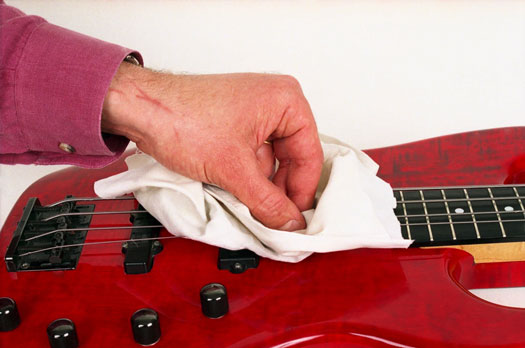Cleaning your bass guitar is the most basic of maintenance jobs, and the first step is to wash your hands. No, really! The finish on the wood and hardware shows every fingerprint. So the least you should do is keep those fingerprints clean The next few sections walk you through cleaning the various parts of your bass, one by one.
The body and neck
Cleaning the body of your bass is just like cleaning your favorite antique furniture: You need to do it very carefully. You can polish the finish with a cloth (such as an old sweatshirt), but use guitar polish (available in a spray bottle at any music store) instead of furniture polish. Guitar polish gets dust and dirt off your instrument and leaves your bass looking well cared for.
Apply a squirt or two of the polish to the cloth and work it into the fabric. Then rub your bass down — work on the body (front and back) and the back of the neck. Your bass will love it. Keep the polish away from the strings and the fingerboard, though.
The hardware
The hardware consists of all the brass and metal parts attached to the wood, with the exception of the frets and pickups. The tuning heads, bridge, and strap pins are all considered hardware. Rubbing the hardware down with a dust cloth helps keep it shiny. If too much dirt builds up on the hardware, you can use a mild brass polish from the supermarket to clean the metal. Make sure that the polish isn't abrasive and that it doesn't get onto the wood, because it will mar the wood.
The pickups
When it comes to cleaning your bass, the pickups are in a category all by themselves. A lot of dust accumulates where the wood meets the metal of the pickups.
Whatever you do, don't use any liquids. Pickups are magnetic, and they can't deal with liquid. The liquid can cause them to short out, making it necessary to replace them.
Of course, getting new pickups every four weeks is one way to keep them clean. Otherwise, use cotton swabs to clean the area where your pickups meet the wood.
The fingerboard
The fingerboard consists of two major parts:
- The long wooden strip on the front of the neck
- The metal frets embedded in the long wooden strip
These two parts are made of very different materials, and each needs to be cleaned in its own special way. You can clean them only after removing your old strings and before restringing.
The wood
Because the wood on your fingerboard is normally exposed, it's prone to drying out. To restore the wood to its original luster, use a dry cloth to get rid of the dirt, and then place a few drops (no more than five or so) of fingerboard oil (which you can get from your local music store) on a clean cotton cloth and work it into the wood. Let the oil dry thoroughly before rubbing down the fingerboard again to remove any excess oil. Apply oil to the wood every other time you change the strings. The wood absorbs fingerboard oil easily.
The frets
You can use a jewelry polishing cloth that has polish already soaked into it (available in any supermarket) to polish the frets. The cloth is inexpensive, and your frets will sparkle with joy (maybe not as bright as diamonds, but you never know).
When polishing the frets, don't use an abrasive jewelry polish that you have to pour out of a bottle. That stuff is rough on the wood of the fingerboard.
The strings
Yes, the strings need to be cleaned, as well. After all, they take the most abuse. You can simply wipe the strings with a dry cotton cloth after you're done playing. But using a couple drops of rubbing alcohol (available in any pharmacy) on a cotton cloth is even better.
Let the alcohol sink into the cloth for a few seconds. Then put a moist section of the cloth between your index finger and thumb and pinch one string at a time, rubbing the cloth up and down along the string's length.
Don't get any of the alcohol on the wood; it'll dry it out.
Check out Figure 1 for the proper method for cleaning bass strings.

Figure 1: Cleaning the strings.

